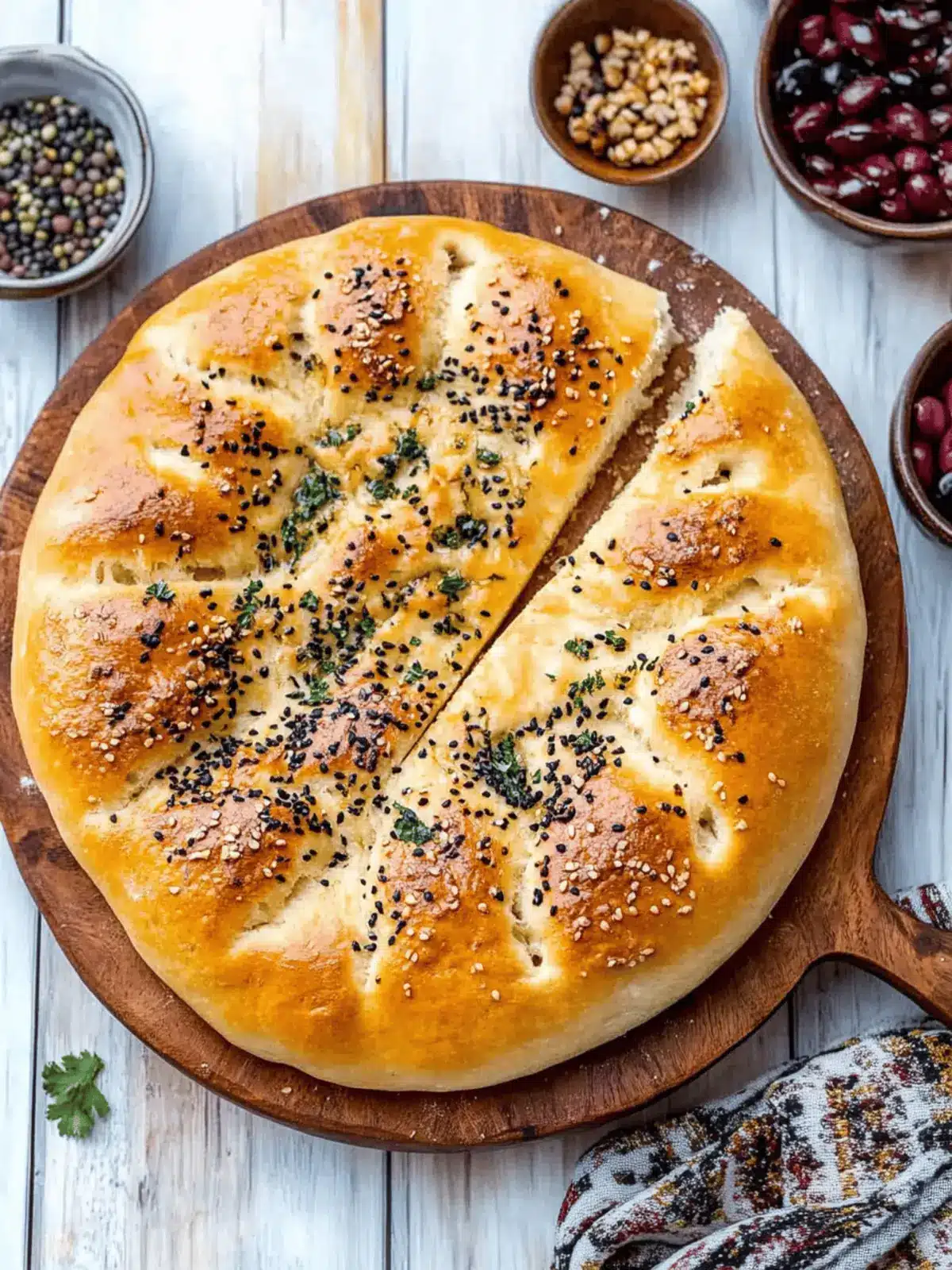It was a chilly evening, and the fragrant aroma of freshly baked bread wafted through my home, wrapping me in warmth and comfort. As I pulled my golden Turkish Bread from the oven, I couldn’t help but feel a wave of nostalgia rush over me. This easy, crowd-pleasing recipe has a delightful crispness outside, with a soft, pillowy center that just beckons to be torn apart and smeared with your favorite dips.
Whether you’re looking to elevate your weeknight dinners or impress friends at your next gathering, this Turkish Bread is the perfect canvas. It’s versatile enough to pair with savory spreads or sweet delights. Plus, the satisfying crunch of sesame seeds on top adds a touch of elegance without requiring any culinary expertise.
Join me in exploring this simple yet rewarding adventure of making Turkish Bread from scratch—it’s a delicious step away from the mundane fast food fare and a delightful way to welcome homemade goodness into your kitchen!
Why is Turkish Bread a Must-Try?
Deliciously Homemade: The warmth of freshly baked Turkish Bread elevates any meal, making it the perfect companion for soups, stews, or dips.
Quick Prep: With just 10 minutes of hands-on time, this recipe easily fits into your busy schedule.
Impressive Result: Your guests will rave about the aromatic flavors and golden crust—even if you’re not a seasoned chef!
Customizable: Whether you prefer savory spices or a touch of sweetness, you can easily adapt the dough to your taste.
Comforting Texture: The combination of a crispy exterior and a soft interior means each bite is a delightful experience.
Crowd-Pleaser: Serve it warm at gatherings, and watch it disappear—everyone loves a slice of homemade bread! For more ideas on what to serve it with, check out my dips and spreads.
Turkish Bread Ingredients
Get ready to bake! Here’s what you need to make this delightful treat.
For the Dough
- Bread flour – 270 g (2 ¼ cups) plus more for dusting; this provides the perfect structure for your Turkish Bread.
- Sugar – 1 tbsp; it enhances the flavor and helps the yeast work its magic.
- Salt – 1 tsp; essential for balancing the flavors and enhancing the bread’s taste.
- Rapid rise dried yeast – 2 ¼ tsp (1x7g packet); this ensures a quick and easy rise for your dough.
- Plant milk – 240 ml (1 cup), lukewarm; it activates the yeast and keeps your bread moist.
- Olive oil – 2 tbsp; this adds richness and keeps the bread tender.
For the Baking Tray
- Semolina – 1 tbsp; sprinkle this on your baking tray to prevent sticking and add a lovely texture.
For the Finish
- Oat or soy cream – 2 tbsp; brushed on top to give your Turkish Bread a golden sheen as it bakes.
- White and black sesame seeds – 1 tbsp; these provide a delightful crunch and nutty flavor that complements the bread beautifully.
Making Turkish Bread isn’t just about the ingredients; it’s about creating an experience you can share with loved ones. Enjoy the process!
How to Make Turkish Bread
-
Combine Ingredients: Measure the flour into a mixing bowl and stir in the sugar, salt, and yeast to create the foundation for your Turkish Bread.
-
Add Milk: Pour in the lukewarm plant milk and stir with a dough hook or wooden spoon until you have a cohesive mixture.
-
Incorporate Oil: Add the olive oil and stir once more, making sure to scrape down the sides of the bowl to incorporate all ingredients well.
-
Let Rise: Cover the bowl with a clean linen towel and place it in a warm area for about 1 hour or until the dough has doubled in size.
-
Shape Dough: Dust your worktop with flour, tip the dough onto it, and sprinkle more flour on top before shaping it gently into a circle.
-
Prepare Baking Tray: Dust a lined baking tray with semolina and transfer the dough onto it, creating a smaller inner ring along the outer edge using your fingertips.
-
Score the Dough: With a sharp knife or your fingertips, create a cross on the inner circle, followed by diagonal lines to form 8 sections.
-
Second Rise: Cover the dough loosely with cling film and let it rise for another 30-40 minutes while preheating your oven to 220° C (430° F).
-
Add Texture: Dent the dough gently along the scored pattern you created earlier. Brush it with oat cream and sprinkle sesame seeds over the top for a crunchy finish.
-
Bake: Place the tray in the center of the oven and bake for 15-20 minutes, until the bread is golden brown and fragrant.
-
Cool & Serve: Allow the bread to cool slightly before tearing it into delightful slices. Serve warm with your favorite dips for a delightful experience!
Optional: Pair with a drizzle of olive oil or your favorite dip for an extra flavor boost.
Exact quantities are listed in the recipe card below.

Make Ahead Options
These Turkish Bread are perfect for meal prep enthusiasts! You can prepare the dough up to 24 hours in advance by following the first five steps and then covering the bowl tightly with cling film before refrigerating it. If you’re short on time, shape the dough and place it on the semolina-dusted tray, then cover loosely and let it rise in the fridge for about 3 hours prior to baking—this will keep the flavors fresh and prevent browning. When ready to serve, simply dent the dough, brush with oat cream, sprinkle on sesame seeds, and bake as directed for warm, delicious results without the last-minute rush. Enjoy the lovely aroma of freshly baked Turkish Bread with minimal effort on busy weeknights!
Expert Tips for Turkish Bread
-
Choose the Right Flour: Use high-quality bread flour for the best structure. Avoid all-purpose flour, as it may lead to a denser texture.
-
Milk Temperature Matters: Make sure the plant milk is lukewarm, as excessively hot milk can kill the yeast, preventing your Turkish Bread from rising properly.
-
Knead Lightly: Avoid over-kneading the dough. A gentle hand is key to keeping that tender crumb we all love—stop when the dough is smooth!
-
Ideal Rising Conditions: Ensure your dough rises in a warm spot. If your kitchen is cool, consider placing it near a heating element for optimal growth.
-
Score with Care: When scoring the dough, be gentle yet firm. This allows the bread to expand beautifully while providing a lovely design.
-
Don’t Rush the Bake: Keep an eye on your bread towards the end of baking. Ovens vary, so check for the golden crust to avoid over-baking your delicious Turkish Bread!
How to Store and Freeze Turkish Bread
Room Temperature: Store your Turkish Bread in an airtight container at room temperature for up to 3 days to maintain its freshness.
Fridge: If you want to extend the shelf life, wrap the bread in plastic wrap and place it in the fridge for up to 5 days; however, this may slightly affect the texture.
Freezer: Freeze Turkish Bread by wrapping it tightly in plastic wrap and then placing it in a freezer bag. It can be stored for up to 3 months.
Reheating: To enjoy your bread warmth, simply reheat it in a preheated oven at 180° C (350° F) for about 10-15 minutes, making it feel freshly baked again!
What to Serve with Turkish Bread?
The comforting aroma of fresh Turkish Bread creates the perfect atmosphere for a delightful meal filled with warmth and flavor.
- Hummus: A classic pairing, its creamy texture and earthy flavor beautifully complement the soft, pillowy bread.
- Tzatziki Sauce: This refreshing yogurt dip adds a cool contrast that balances the warmth and sweetness of the bread.
- Olive Tapenade: A savory blend of olives enhances every bite, bringing a rich, briny flavor that pairs wonderfully with Turkish Bread.
- Roasted Vegetables: Colorful roasted veggies add a medley of flavors and textures, making for a vibrant and wholesome platter.
- Lentil Soup: Serve with a bowl of hearty lentil soup for a satisfying, cozy meal that hugs the heart.
- Feta Cheese: Crumbled feta sprinkled on top provides a creamy, tangy element that elevates your bread indulgence.
- Stuffed Grape Leaves: The tangy and herbal notes from dolmas create an appealing flavor contrast when enjoyed with the warm bread.
- Turkish Tea: Complement your meal with a cup of traditional Turkish tea for a fragrant end note that ties everything together.
Turkish Bread Variations
Feel free to get creative and add your personal touch to this delightful Turkish Bread recipe!
-
Whole Wheat: Substitute half of the bread flour with whole wheat flour for a nuttier flavor and added fiber.
This adds a wholesome touch while still keeping the bread soft and delicious. -
Herb Infusion: Mix rosemary, thyme, or oregano into the dough for fragrant, flavorful twists.
This will elevate your bread from simple to sensational, perfect for pairing with soups. -
Cheesy Delight: Incorporate shredded cheese, like feta or mozzarella, into the dough before shaping.
The melty cheese adds an irresistible richness to your bread, making it a true indulgence! -
Spicy Kick: Add crushed red pepper flakes or freshly chopped jalapeños for a spicy version.
This fiery addition transforms the bread into a wonderful sidekick for dips, delivering excitement in every bite. -
Nutty Flavor: Fold in chopped walnuts or sunflower seeds for added texture and a hint of nuttiness.
This delightful textural contrast not only makes the bread more interesting but also adds healthy fats. -
Sweet Twist: Experiment by adding a tablespoon of honey or maple syrup and a touch of cinnamon for a sweet version.
Serve it warm with butter or jam for a comforting treat perfect for breakfast or dessert! -
Gluten-Free: Replace the bread flour with a gluten-free flour blend suitable for baking.
This variation allows everyone to enjoy the homemade goodness without compromising on taste. -
Topped Temptation: Try brushing the top with garlic oil or a blend of herbs before adding sesame seeds for extra flavor.
This will create an aromatic crust that will make your Turkish Bread the centerpiece of any meal!

Turkish Bread Recipe FAQs
How do I choose the right flour for Turkish Bread?
Absolutely! For the best texture and structure, opt for high-quality bread flour rather than all-purpose flour. Bread flour has a higher protein content, which gives your Turkish Bread that delightful chewiness we all love. Look for a flour with a protein content of around 12-14% for optimal results.
How should I store Turkish Bread to keep it fresh?
To enjoy your Turkish Bread at its best, store it in an airtight container at room temperature for up to 3 days. If you want to prolong its freshness, wrap it tightly in plastic wrap and refrigerate for up to 5 days. Just remember that chilling might alter the texture slightly, making it a bit drier.
Can I freeze Turkish Bread?
Yes, indeed! To freeze your Turkish Bread, first, let it cool completely. Then, wrap it tightly in plastic wrap and place it in a freezer bag. Seal it well to prevent freezer burn, and it will keep for up to 3 months. When you’re ready to enjoy it, simply thaw overnight in the fridge and reheat in a preheated oven at 180° C (350° F) for about 10-15 minutes for that fresh-baked taste!
What should I do if my dough doesn’t rise properly?
Very frustrating, but it can happen! If your dough doesn’t rise, first check that your yeast is fresh. To troubleshoot, you might want to create a warm environment for the dough using your oven—simply turn it on for a couple of minutes, then turn it off. Place the dough inside, covered with a towel, and let it rise for another 30-40 minutes. If it still refuses to rise, it might be too old, and starting with fresh yeast would be best.
Can I make this recipe gluten-free?
While I recommend sticking with bread flour for the best texture, you can definitely experiment with gluten-free flour blends if needed! Be sure to add a binder like xanthan gum or chia seeds to help mimic the structure that gluten provides. Keep in mind that you may need to adjust water content, as gluten-free flours can absorb liquid differently.
Is Turkish Bread suitable for my pet?
It’s best to keep Turkish Bread away from your furry friends. Although the ingredients are safe for humans, bread can cause digestive issues in pets, particularly due to the yeast and salt content. Always stick to foods made specifically for them to ensure their health and happiness.

Mouthwatering Turkish Bread: Easy Recipe for Fresh Flavor
Ingredients
Equipment
Method
- Measure the flour into a mixing bowl and stir in the sugar, salt, and yeast.
- Pour in the lukewarm plant milk and stir with a dough hook or wooden spoon until cohesive.
- Add the olive oil and stir again, scraping down the sides of the bowl.
- Cover the bowl with a linen towel and let it rise in a warm area for about 1 hour until doubled.
- Dust your worktop with flour, tip the dough onto it, and shape it gently into a circle.
- Dust a lined baking tray with semolina and transfer the dough onto it.
- Create a cross on the inner circle with a sharp knife or fingertips, forming 8 sections.
- Cover the dough loosely with cling film and let it rise for another 30-40 minutes.
- Dent the dough gently along the scored pattern, then brush it with oat cream and sprinkle sesame seeds.
- Place the tray in the oven and bake for 15-20 minutes until golden brown and fragrant.
- Allow the bread to cool slightly before tearing it into slices.






